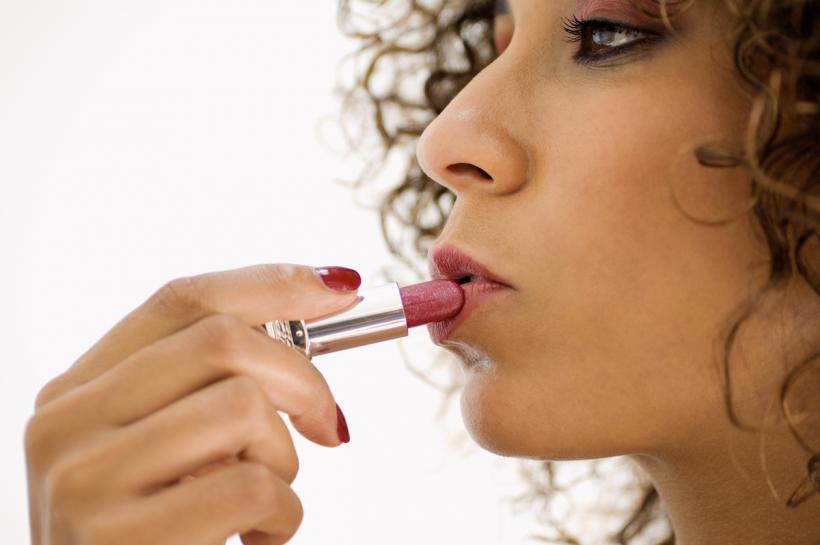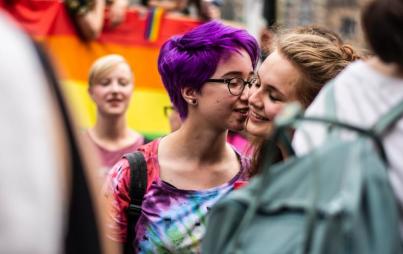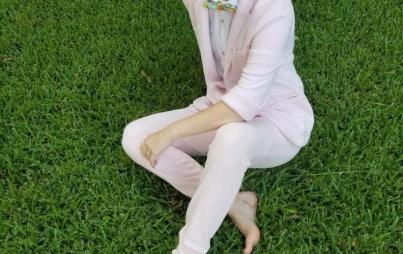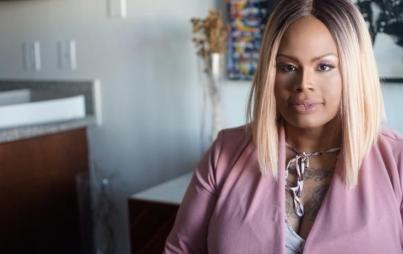
Once I realized that I could embrace the parts of femme that I liked (lipstick! frilly skirts!) and reject the ones that didn’t work for me (shaving! heels!) things got a hell of a lot easier.
Admitting that I legitimately wanted to wear bright red lipstick — even though I felt self-conscious in it, like it wasn’t “for me” — created a tiny opening which eventually let in the flood of femme.
My kid was laughing, watching me put on lipstick. I learned how to put on lipstick from this tutorial on ROOKIE (an amazing online magazine that I love at the tender age of 30, despite it being predominantly by and for teen girls).
My kid laughed as I carefully traced the liner, and then the lipstick itself, and smacked my lips together before blotting them. He’s just a baby, only nine-months-old, but for him, this — watching mama put on lipstick — is a normal part of his life. It’s not an everyday occurrence, but it’s regular enough, and it is something he understands as joyful and exciting.
I feel pretty much the same way about it.
Growing up, I was what was called a “girly-girl.” I loved frilly and poofy dresses. I loved my long blonde hair. I loved dolls of all sorts and My Little Ponies (this was way before bronies y’all!) and I was totally obsessed with The Little Mermaid.
My identity wasn’t a monolith — I also loved Batman and would come home from school with my braids matted with mud — but overall I read as “girly.” Especially next to the rest of my family.
I sometimes jokingly refer to my mother as “the butchest straight woman I have ever known.” That’s not really fair. She doesn’t actually identify with the word “butch,” but she is a woman who served in the army reserves when I was young, who loathes makeup, who doesn’t pluck her eyebrows, and who hates high heels.
My mother spent her childhood fighting like hell for the right to wear pants and go fishing with the boys. My older sister occupied a space somewhere in the middle, neither as much of a tomboy as my mom or as girly as me. And my fascination with everything feminine was an anomaly within the confines of my family, something novel and strange.
I was never really butch — I never owned that word — but I was just butch enough.
But everything changes; kids grow up. As a teenager, the rules of femininity morphed and became more severe. At 11, I was trying to figure out how to use concealer “the right way” and feeling like an imposter. By 12, I felt like all the other girls must be having secret meetings in which they learned important skills like how to shave your legs without multiple injuries, how to walk in heels (which also can lead to injuries!), and how to pick out eye shadow that wasn’t “too flashy.”
Faced by the extreme pressure to conform to impossible beauty ideals, I followed my instincts (and my budding feminism), rejecting them wholesale. I wasn’t going to play like that; I wasn’t going to let my gender require that I wear makeup or perform a certain way. At 19, a girl I was crushing on turned me down because she tended to like girlier girls. I looked down at my hairy legs and sighed.
Things changed again when, at the ripe old age of 23, I finally uttered the word “gay” about myself. But really things had been changing for years. I sheared off my hair every spring. I kept my fingernails short and practical. I was never really butch — I never owned that word — but I was just butch enough.
I was just butch enough to get called “sir” on the street in the winter. I was just butch enough to appeal to a certain kind of femme girl. I wore a fair amount of flannel.
So what changed? Looking back on it, a lot of it was that lipstick tutorial. Admitting that I legitimately wanted to wear bright red lipstick (even though I felt self-conscious in it, like it wasn’t “for me”) created a tiny opening which eventually let in the flood of femme. Thanks, internet.
“Femme” isn’t the same thing as “feminine.” But it is related.
Once I let go of the fear that being femme meant being a “feminine lesbian” who would date, love, and fuck, “butch lesbians” things got easier. Once I watched multiple friends go through the process of finding their own gender identity and getting comfortable in their own skins, things got easier.
I could be the weirdo queer femme of my own dreams.
Once I realized that I could embrace the parts of femme that I liked (lipstick! frilly skirts!) and reject the ones that didn’t work for me (shaving! heels!) things got a hell of a lot easier. I was toying with it, dipping my toe in, thinking, Maybe I could be femme... sometimes.
Then I had a baby.
After having said baby, I just did not give a fuck. After being so tired and defeated and fucking wrecked from bringing new life into the world, I no longer had time to worry about whether or not the things that I wanted were “for me” or not. And then I had this conversation with my wife, about wanting to give our son greater gender freedom. Two days later, it was like something opened up in my mind and everything made sense. I dyed my hair green.
Oh. I could be the weirdo queer femme of my own dreams. OK, then!
In February, at a local art show, I read the whole terrible story of my kid’s birth to a room full of people. I was nervous, I hadn’t read anything in public in a long time, and I honestly don’t get out that much now that I have a kid. Rather than practicing my reading, I put my hair in pin curls. I wore this incredible matte black lipstick. I bought a new dress that I couldn’t afford, one that fit my new body.
When a friend came to drive up my little family to the event, he stood in our doorway and said, “Wow, you look fantastic!”
I smiled at him.
“Thank you!” I said. “I’m trying really hard,” I said.
Finally allowing myself to try to be femme makes me feel safe and free in a way I cannot even explain.








